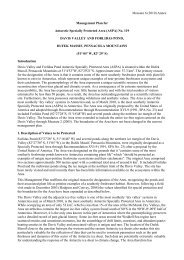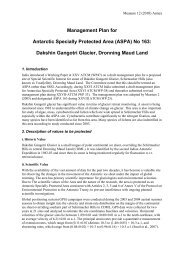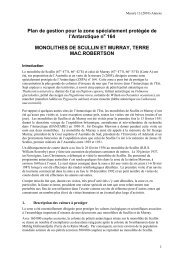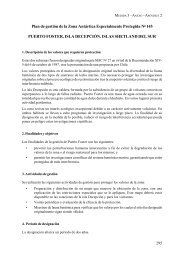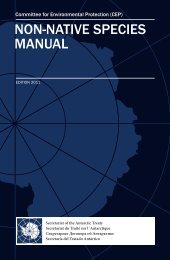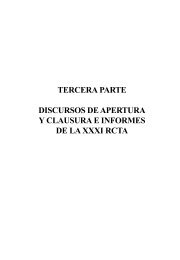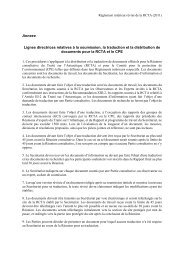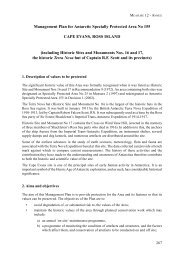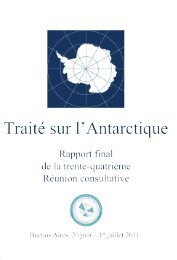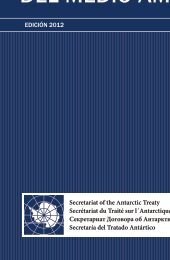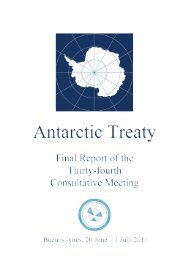Scott Base and McMurdo Station - Antarctic Treaty Secretariat
Scott Base and McMurdo Station - Antarctic Treaty Secretariat
Scott Base and McMurdo Station - Antarctic Treaty Secretariat
Create successful ePaper yourself
Turn your PDF publications into a flip-book with our unique Google optimized e-Paper software.
Science undertaken at <strong>Scott</strong> <strong>Base</strong>The Hatherton Laboratory supports ionosonde soundings which have been taken continuously for 25 years;fluxgate magnetometers; meteorological observations which have been continuous at the site since 1957; seismicobservations on behalf of the USGO; upper atmosphere winds; polarimeter observations; <strong>and</strong> a chlorine oxideexperiment with 9 years continuous measurements. The laboratory also supports Malaysian programs include aTrimble reference station for GPS monitoring; an all-sky camera used in winter for web-based educationprograms; <strong>and</strong> a grid of four automatic weather stations on the ice shelf for detecting atmospheric turbulence <strong>and</strong>gravity waves.Power generationThree 225 kVA generators supply <strong>Scott</strong> <strong>Base</strong> of which two are in the main power house <strong>and</strong> a separate one is foremergency use. There is one power control system.Fuel storage <strong>and</strong> h<strong>and</strong>lingThe main fuel used at <strong>Scott</strong> <strong>Base</strong> is AN8 diesel fuel. Over 450,000 litres are consumed annually. The fuel ispurchased from <strong>McMurdo</strong> <strong>Station</strong> <strong>and</strong> 56,000 litres (enough for about 6 weeks) can be stored in a double-walledtank at <strong>Scott</strong> <strong>Base</strong>. Fuel is transported from <strong>McMurdo</strong> in a 7,000 litre trailer-mounted tank. AN8 is distributedaround the station by pipe - welded stainless steel above ground, <strong>and</strong> underground in flexible fuel hose protectedby galvanised steel pipe. The main storage tank <strong>and</strong> day tanks (all of which are also double-walled) are protectedby high <strong>and</strong> low level alarms. Vehicles are refuelled from a bowser installed on a concrete pan with a closedcatchment to allow complete recovery of any spills. In the unlikely event of catastrophic failure of the mainstorage tank <strong>and</strong> containment, escaping fuel would be absorbed into the ground or discharge to the sea 50 metresfrom the tank.Spill response materials are readily available within the station <strong>and</strong> in a container alongside the main storage tank.However, the quantity of material seemed of limited capacity for anything other than a minor spill. The risk offuel spills is minimised by st<strong>and</strong>ardising on AN8 fuel with its well developed storage <strong>and</strong> transfer systems. Wewere advised that the weakest link in the fuel h<strong>and</strong>ling system is the risk of accident during overl<strong>and</strong> transport offuel from <strong>McMurdo</strong> <strong>Station</strong>.The helipads at <strong>Scott</strong> <strong>Base</strong> are within 50 metres of the main fuel storage tank.Mogas (petrol) is transported <strong>and</strong> stored in a 2,000 litre trailer-mounted tank. This tank trailer is parked on itsown concrete pan with a closed catchment sump to allow recovery of any spills.Smaller amounts of fuels are stored <strong>and</strong> transported in various containers <strong>and</strong> drums of up to 200 litres. Day tanksat the base are double-walled, <strong>and</strong> day tanks on sled-mounted vans have drip trays.Energy efficiency auditWe were advised that at <strong>Scott</strong> <strong>Base</strong> the most energy intensive activities are heating <strong>and</strong> production of waterthrough reverse osmosis. <strong>Antarctic</strong>a New Zeal<strong>and</strong> is currently looking at the potential for fuel savings byimproving energy efficiency within the buildings. The Hillary Field Centre has been designed to maximise energyefficiency which is important given that it represents one third of the station’s heated air space. Strict waterconservation practices reduce the energy dem<strong>and</strong> for water production <strong>and</strong> toilets are flushed with sea water. Thekitchen has been converted to gas cooking to flatten the peaks in the power dem<strong>and</strong>.VehiclesThere are few vehicles at <strong>Scott</strong> <strong>Base</strong> <strong>and</strong> they are modest in size. The fleet appears to be in good working order<strong>and</strong> there was no evidence of unserviceable vehicles or machinery lying around.Permafrost issuesThe high melt experienced in the 2004/05 summer appears to have caused some movement in facilities anchoredin the permafrost. This was evident in the movement of stanchions supporting the waste water treatment outfallpipe where it circumnavigates “Hut A” in an area prone to pooling, <strong>and</strong> in the anchors to one of themagnetometer huts. These issues are probably short lived <strong>and</strong> not of immediate environmental significance butwere promptly attended to by the engineer.



